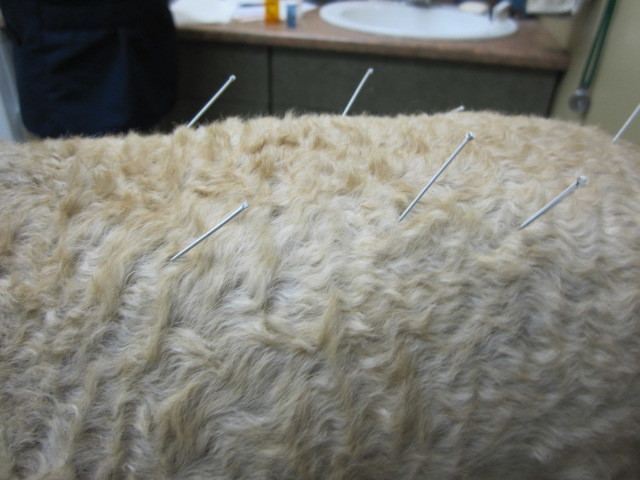 | ||
Veterinary acupuncture is the practice of performing acupuncture on animals.
Contents
History
Traditional Chinese veterinary medicine (TCVM) has been practiced on animals for thousands of years. For nearly 3,000 years, from the Zhou dynasty and the reign of Emperor Mu around 930 B.C., up until the Yuan dynasty of the 14th century, Chinese medicine was used sparingly on large animals. Much of the focus was on the treatment of horses since they were so essential to the military. In more modern times it has been used increasingly on pet animals. Acupuncture is one of the five branches of TCVM.
In historical Asian culture, people known as "horse priests" commonly used acupuncture. The flow of information from the East to the West regarding animal treatment, including acupuncture, is thought to have started from Mesopotamia around 300 BC. Acupuncture remained a major interest in veterinary medicine for centuries. Its use for dogs was first described in the Tang Dynasty.
In the 20th century, animal acupuncture was first introduced in the United States in 1971 by two acupuncturists of the National Acupuncture Association, Gene Bruno and John Ottaviano. In the process of treating thousands of small animals and several hundred horses, Bruno and Ottaviano trained veterinarians who later founded the International Veterinary Acupuncture Society (IVAS). The demand for veterinary acupuncture has steadily increased since the 1990s.
Practice
Acupuncture is used mainly for functional problems such as those involving noninfectious inflammation, paralysis, or pain. For small animals, acupuncture has been used for treating arthritis, hip dysplasia, lick granuloma, feline asthma, diarrhea, and certain reproductive problems. For larger animals, acupuncture has been used for treating downer cow syndrome, facial nerve paralysis, allergic dermatitis, respiratory problems, nonsurgical colic, and certain reproductive disorders. Acupuncture has also been used on competitive animals, such as those involved in racing and showing. Veterinary acupuncture has also recently been used on more exotic animals, such as chimpanzees (Pan troglodytes) and an alligator with scoliosis, though this is still quite rare.
Mechanism
Research on the mechanism of acupuncture began as early as 1976 with the introduction of the endorphin hypothesis and the gate control theory of pain, which accounts for the inhibition of nociceptive information via interneurons. Stimulation of nerve fibres contributes to the release of cytokines and inflammatory mediators around the needle as part of a neuromodulatory process resulting from the needling effect on connective tissue and fibroblasts. In response to needle stimulation, neuropeptides are released into the local blood flow. These neuropeptides include calcitonin gene-related peptide (CGRP), nerve growth factor, substance P, and vasoactive intestinal peptide.
In recent years, research has been prompted by the introduction of neuroimaging techniques such as functional magnetic resonance imaging (fMRI) and positron emission tomography (PET), both of which have further elucidated the relation between acupuncture stimulation and activation of neural structures. In addition, deactivation of the limbic system by acupuncture stimulation has been reported in human studies, possibly accounting for its sedative effect in horses. A diverse array of neurotransmitters and receptors contribute to acupuncture analgesia including opioids, glutamate and NMDA receptors, serotonin and cholecystokinins. The autonomic neuromodulatory signaling of tissue cytokines affects both somatic and viseral structures to restore the balance between the parasympathetic nervous system and the sympathetic nervous system. In equine populations, clinical responses may occur within minutes to hours after treatment.
Efficacy
In 2001, a review found insufficient evidence to support equine acupuncture. The review found uniformly negative results in the highest quality studies. In 2006, a systematic review of veterinary acupuncture found "no compelling evidence to recommend or reject acupuncture for any condition in domestic animals", citing trials with, on average, low methodological quality or trials that are in need of independent replication. In 2009, a review on canine arthritis found "weak or no evidence in support of" various treatments, including acupuncture.
Recent (i.e. post-2011) reviews in both veterinary text books and scientific journals indicate that acupuncture can be used for therapeutic or homeostatic effects in animals, especially in the three areas of pain management, geriatric medicine and sports medicine. Conditions that have the best responses to veterinary acupuncture are considered to be pain, immune-related dysfunction and visceral dysfunction.
In 2015, the American Animal Hospital Association (AAHA) and American Association of Feline Practitioners (AAFP) issued joint guidelines for the management of pain in cats and dogs. The guidelines stated, "There is a solid and still growing body of evidence for the use of acupuncture for the treatment of pain in veterinary medicine to the extent that it is now an accepted treatment modality for painful animals."
Related methods
Acupuncture refers to the use of dry needles; however, there are several related methods which do not use these, or may use a modified type of needle or stimulator.
A study on the use of electroacupuncture on dogs after back surgery reported ambiguous results. In the study, the post-operation dogs were assigned a pain score eight times within a 72-hour time-frame. Though significantly lower pain scores were found in the treatment group at 36 hours, the scores did not differ from the control group at any other time.
Organizations
The International Veterinary Acupuncture Society (IVAS) was founded in the US in 1974 and the first certification exam was held in 1975 when there were only 80 members of the society. IVAS has grown worldwide and in 2015 the membership exceeds 1,800. The Association of British Veterinary Acupuncturists was formed in 1987. In 2014, American Veterinary Medical Association (AVMA) admitted the American Academy of Veterinary Acupuncture (AAVA) as a "Constituent Allied Veterinary Organization". The American Board of Animal Acupuncture (ABAA) is the only certification agency for licensed acupuncturists practicing animal acupuncture in the US.
